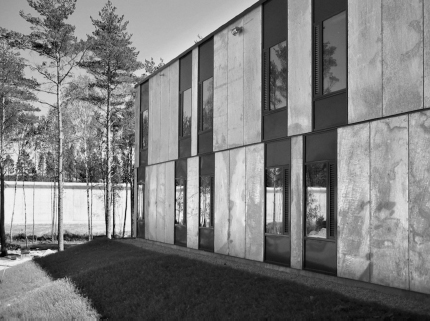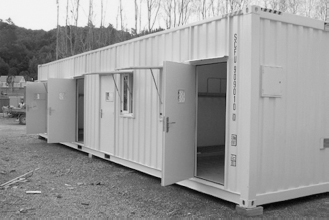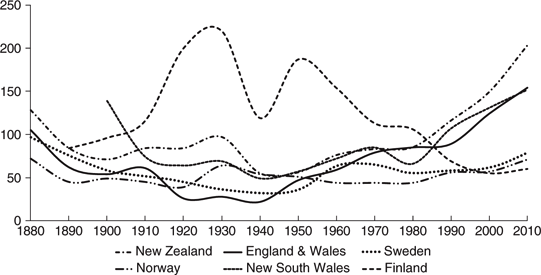
Two prisons, two kinds of societies
A feature article in Time magazine (May 2010: 18) carried the headline, ‘Norway Builds the World’s Most Humane Prison’. It went on to state that the King of Norway had formally opened Halden prison (see Figure 0.1), accompanied by a chorus of 30 men and women, each wearing a blue [prison officer] uniform, who gave a ’spirited rendition of “We Are the World”’. The prison’s amenities included ‘a sound studio, jogging trails and a freestanding two-bedroom house where inmates can host their families during overnight visits’. Furthermore, ‘the air isn’t tinged with the smell of sweat and urine. Instead, the scent of orange sorbet emanates from the “kitchen laboratory” where inmates take cooking courses.’ The prison was designed so that it ‘looks as much like the outside world as possible’, its architect explained. To avoid an institutional atmosphere, ‘exteriors are not concrete but made of bricks, galvanized steel and larch; the buildings seem to have grown organically from the woodlands’. While there is ‘one obvious sign of incarceration – a six metre concrete security wall along the prison’s perimeter – trees obscure it and its top has been rounded off “so it isn’t too hostile”’.Within the prison, the reporter noted that ‘the cells rival well-appointed college dorm rooms, with their flatscreen TVs and minifridges. Designers chose long vertical windows because they let in more sunlight … every 10 to 12 cells share a living room and kitchen. With their stainless steel countertops, wraparound sofas and birch coloured coffee tables, they resemble IKEA showrooms … Prison guards don’t carry guns … and they routinely eat meals and play sports with inmates.’
Different prison arrangements were reported in New Zealand’s Sunday Star Times (21 June 2009: 1) under the headline ‘Inmates Told: Build Your Own Jail Cells’. Here, the report continued, ‘prisoners could be forced to build their own jail cells from shipping containers to cope with a “dangerously high” prison population that is expected to spill over in six months. It is the latest of the government’s hardline “tough on crime” measures.’ Opening the unit, the Corrections Minister stated that using prisoners to build their own cells was ‘a great idea’. The cells would be ’spartan but humane and clean… prisoners need to learn construction skills so they can earn their keep and frankly, it’s a lot better than being locked up all day in a cell … the shipping containers would provide a better standard of housing than some of the country’s older prisons’. A 78-bed unit opened a year later, consisting of 13 twelve-metre-long containers, each of which had been converted into three cells (see Figure 0.2). Each of the cells (six metres by three metres) accommodates two men. Justifying these measures, the Corrections Minister informed her audience ofjournalists that ‘[these] are actually prison cells at the end of the day. They are not a holiday camp, even though there is an outside space and they are very humane … crime is voluntary. If people want to commit crimes, there is going to be a response and the response may well be prison’ (AM, abc.net.au, 5 June 2010).
Two episodes in contemporary prison development from two modern societies, each representing very different ways of thinking about punishment. In the first, the investment in what is acclaimed as humane prison design in Norway is celebrated by prison management, staff, and the highest state authorities. All the usual indicators of prison existence have been variously camouflaged, hidden or removed. No expense has been spared, it seems, to make this prison look ‘as much like the outside world as possible’. The symbolic importance of a prison of this nature for the country as a whole, not just the prison service, is recognized by the presence of the Norwegian monarch at the opening ceremony – here was a country, it seemed to say, that responds to lawbreakers with humanity and tolerance, and is proud of this. In contrast, the report from New Zealand indicates that every expense has been cut back as far as possible.
Traditional methods of prison construction have thus been bypassed as the shipping containers are converted into cells, using cheap prison labour – at around a maximum of $NZ30 per week, prisoner wages in this country are negligible – for this purpose. Here was a country, it seemed to say, that liked to boast of the severity of its response to crime: the plans for the new unit were thus one part of a broader package of ‘tough on crime’ measures (which, at that time, included ‘removing parole eligibility for the worst repeat violent offenders, allowing the cars of illegal street racers to be crushed and the seizure of the assets and profits of gangs … [and tightening] prison release conditions for serious child sex-offenders’). There was no head of state to open the unit – what happened in these nether reaches of New Zealand society was not a matter with which dignitaries should concern themselves; nor was there any choir of guards to hymn in proclamation. Instead, the Minister of Corrections took the opportunity to justify the initiative to the media from the perspective of her political party. At pains to point out the absence of anything that could be considered a luxury, it was the ‘spartan’ nature of this initiative that was celebrated. There was no attempt to disguise these aspects of the unit, save for the throwaway remark that what it offered was preferable to some of the existing New Zealand prisons. Ultimately, her message was that prison cells, and nothing more, were being built. By definition, this meant that expectations about their design and format should be determined by the proviso that their accommodation should not be – could not be – raised above the lowest level of tolerable human existence in this society. If inmates subsequently found such conditions intolerable, then the solution was in their own hands: give up crime, or continue to live in these bleak surrounds.

| Figure 0.1 | Halden Prison, Norway. Photograph: Statsbygg, Norway. |

| Figure 0.2 | Shipping containers that were to be converted into prison cells in New Zealand’s latest prison building scheme to address overcrowding. Photograph: Greenbiz.com. |
Two very different ways, then, of thinking about punishment. However, these differences are not just specific to two small societies that sit at opposite ends of the earth. Instead, as will be set out in more detail in Chapter 1 (Understanding Differences in Punishment), each example is typical of the different ways it has become possible to think about punishment in the clusters of societies to which these two countries belong: the Nordic countries, on the one hand (Finland, Norway and Sweden, for the purposes of this research), and a particular group of Anglophone countries, known as ‘the White Commonwealth’ (England, New Zealand and Australia, with specific emphasis on the state ofNew South Wales,1 for the purposes of this research) on the other. Thus, as regards the remarks about ‘the world’s most humane prison’ and the prison units made from shipping containers, it would be possible to find similar reports to these, or variations on the themes in them, in each of the other societies in the respective clusters to which Norway and New Zealand belong. What we would be most unlikely to find, however, is any cross-cluster transference. Shipping container cells are not part of any aspect of Nordic prison arrangements; in just the same way, it would be inconceivable to find any of these Anglophone countries boasting that they house the world’s most humane prison. The purpose of this book is to explain how it has become possible to think so differently about punishment in these two clusters of societies.
While there are obvious differences between each society in these clusters, they share important commonalities: languages, geographical proximity (as regards the Nordic cluster and Australia and New Zealand), histories, political connections, traditions and ancestries. In relation to the Nordic cluster, Finland was part of Sweden until 1809, before becoming an autonomous Grand Duchy of the Russian Empire until 1917, when it was granted independence. The Finnish language has unique characteristics, but the country is officially bilingual (Finnish/Swedish2). Norway, from 1521 until 1814, was a Danish territory. Thereafter, until 1905, when it declared its independence, it was unified with Sweden (although this seems to have been of a largely nominal nature: the two countries shared the same monarch and the same foreign policy, but Norway had its own constitution). Its own declaration of independence, after a plebiscite in which 99.5 per cent of the population voted in favour of the dissolution with Sweden, was met with jubilation in Norway and sullen acceptance in Sweden. The Norwegian language is very similar to Swedish, although, during the union with Denmark, the official language had been Danish (which is also similar to Norwegian and Swedish). These societies have similar legal systems, based more on civil, rather than common law, and similar electoral systems based on proportional representation. At the same time, each member of these societies is automatically born into the Lutheran Church that, in the past, provided this region with a remarkably high level of religious homogeneity. As regards the Anglophone cluster, the imperial bond and colonial ties – and the resulting shared way of thinking and sense of identity – between England, Australia and New Zealand seems to have been particularly strong. The European settlement of Australia and New Zealand, up to the mid-twentieth century in the former, the 1970s in the latter, had been almost exclusively British. At the same time, ‘the tyranny of distance’ (Blainey, 1966) not only created a close, if sometimes antagonistic, bond between the two remote Southern hemisphere colonies, but also made the ties to Britain all the more insoluble: surrounded, as it were, by ‘nothingness’ on the one hand, hostile indigenous peoples on the other, the sense of ‘Britishness’ in all aspects of colonial life gave the settlers a crucial sense of identity. Ward (2001: 2) thus wrote that ‘for much of the 20th century Australian political culture was characterized by a deep attachment to the British embrace. London formed the centre of an imperial imagination in which Australia was firmly cast as a loyal outpost of British culture and British civilization.’ There is every reason to think that this was even more so in New Zealand. Michael King (2003: 367), one of this country’s leading historians, thus quoted its Governor-General’s comments from 1924 that ‘New Zealanders were “extremely proud” oftheir British nationality. They claim, in fact, to be even more British than the kin of their Motherland, and that no doubt accounts for the intensely loyal spirit which characterizes the Dominion.’
In these respects, then, we have two clusters of societies that operate within much the same parameters, share much the same way of thinking, and share much the same ways of punishing their offenders. As Brodeur (2007: 80) points out, ‘clustering countries are joined by geographical, historical and cultural proximity. Figures correlating rates of imprisonment and influencing variables … show that these relationships hold as much between clusters of countries as between individual nations.’ It also means that generalizations that are made about their penal characteristics carry more weight when they are shown to fit a particular group of societies rather than an individual member of it. But why were these six societies selected in preference to others that could have fitted within each cluster? Obviously, the larger the sample in each cluster, then the stronger the generalizations that can be made about its characteristics. At the same time, though, selection is also determined by pragmatism, especially for multi-society research of this nature. Thus, in relation to the Nordic cluster, it was simply not possible to include Denmark and Iceland for important logistical and financial reasons (see Preface). As regards selection for the Anglophone cluster, the USA was not included because it is a vastly different society from England, New Zealand and Australia in terms of size, history, political structure, race relations, and so on. Although it is a member of the Anglophone world, it is not a member of, and does not share important, unifying characteristics of the White Commonwealth group of nations. But what of Canada, another member of this group? Aside, again, from the logistics and financing that have to be taken into account, there are also good intellectual reasons for not including this country. It seems entirely plausible that colonial ties to England were stronger in New Zealand and Australia than in Canada. For example, Miller (1987: 178) wrote that ‘Australians considered they were more truly Britain’s children than the Canadians (because of the French Canadians) or South Africans (because of the Afrikaners); only the New Zealanders could claim the same outright familial connection, while Indians and Africans and others within the British Empire could claim nothing but efficient administration’. In fact, Miller is understating Canadian differences. It not only had its constituency of French descendants, which has made it a bilingual society but, in addition, from the late nineteenth century, it attracted high levels of immigration from Eastern Europe. Indeed, in the 1920s and 1930s, immigration from this direction outpaced that from the United Kingdom (Bumsted, 1992: 215) – at a time when Australia and New Zealand still operated an almost exclusively ‘British only’ migration policy. Over the same period, there was also significant immigration from the United States. In combination, these demographic patterns are likely to have given Canada a rather more heterogeneous identity than the two Antipodean colonies. British settlement might still have been most dominant there but, unlike Australia and New Zealand, ways of thinking about the world were not restricted to British mentalities. Indeed, the economic power ofthe United States inevitably influenced the development of Canadian markets and culture (Vance, 2009), while it was exclusively Britain that did so in Australia and New Zealand. The subsequent effects of these differences can be seen at all levels of these former colonies. For example, the replication of almost exclusively British sports in Australia and New Zealand, in contrast to those emanating from the USA in Canada; the reluctance ofAustralia and New Zealand, unlike Canada, to sign the 1931 Statute of Westminster, giving these dominions legislative independence and cutting them loose from the colonial umbilical cord;3 the way in which the Australian and New Zealand flags still contain British Union Jacks while, in Canada, this was abandoned in 1965 (seemingly with little dissent) in favour of the maple leaf.
This, then, explains the thinking behind, and justifications for, the selections for the two clusters. But this does not mean, of course, that there have been no differences in the past or present in the penal arrangements of the individual societies that were selected. This is immediately apparent when we examine the respective adult imprisonment rates (the research features their adult, not their juvenile, penal systems) from the late nineteenth to the early twenty-first century of these Anglophone and Nordic societies. As Figure 0.3 shows, there has been a generally uniform pattern of development between the Anglophone countries: from particularly high rates at the end of the nineteenth century, they undergo a significant decline to the mid-twentieth, before rising again. Meanwhile, in the Nordic cluster, the rates for Norway and Sweden have been relatively stable throughout the whole period, despite some recent incline. That for Finland, however, rose dramatically in the first half of the twentieth century, as this country became a victim of its own geopolitical history. In the power vacuum caused by the Russian revolution, right and left political factions armed and organized themselves into White and Red Guards, culminating in civil war in 1918. Bloody reprisals followed the victory of the Whites but, from the 1920s to the early 1960s, in addition to dire poverty and an agrarian, rather than an industrial, economy, there was also a profound political silence over these events. This meant that there was no opportunity for healing and reconciliation, and it also meant that Finnish society was, in effect, frozen in time (Kekkonen, 1999). A thawing out only began to occur when this country rejoined the Nordic family of nations in the 1960s. Thereafter, its dramatic decline in imprisonment begins, as its penal programme assumed a more familiar Nordic identity.
What the Finnish divergence indicates is the way in which it is possible for a ‘normal level of punishment’, under extreme circumstances, to be torn right away from its anchorage, and sent off into uncharted territory. There is no guarantee that the characteristics of punishment will remain fixed and certain in each of these societies. However, the fact that Finland has since made it back to a more familiar harbour illustrates the presence of a longstanding and prevailing sense of shared penal identity within each cluster that, even though it can be disrupted and thrown off course at times, is not erased altogether; an identity that, as eminences such as Fyodor Dostoyevsky, Sir Winston Churchill and Nelson Mandela4 have suggested, also tells us a great deal about the kinds of societies that they have been and the kinds of societies they have become.

| Figure 0.3 | Imprisonment rates, 1880–2010 (all six societies). |
Sources: New Zealand: New Zealand Yearbook (various); Department of Justice (1981, 1991, 2008). England and Wales: Home Office (2003). New South Wales: Official Yearbook of New South Wales (various); Australian Bureau of Statistics (1982, 2000). Finland: Christie (1968); Falck, von Hofer and Storgaard (2003); Statistics Finland (2012a). Sweden: Christie (1968); Falck, von Hofer and Storgaard (2003). Norway: Christie (1968); Statistics Norway (2012a). All countries: World Prison Brief (2010).